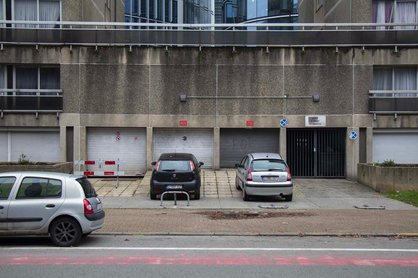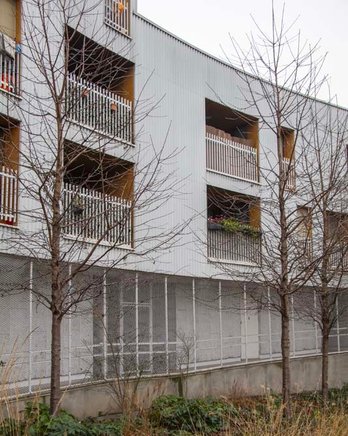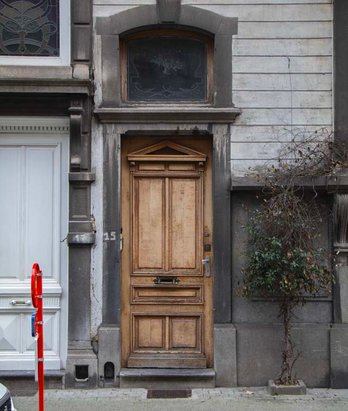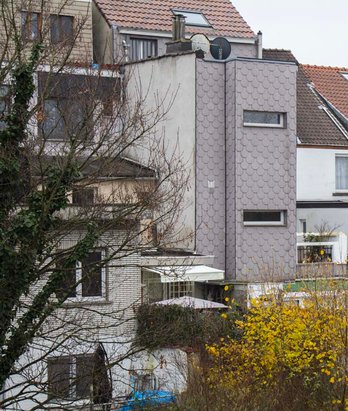
Changing the use of a building can quickly become complicated. In Belgium, "change of use" is often subject to strict rules. This guide explains when a permit is required and the steps to follow.
A change of use modifies the intended use of a building or plot of land. These transformations often have an impact on local planning regulations.
A change of use modifies the function assigned to a property. For example, turning a house into a business. This function is defined by the planning permission or land-use plans.
All buildings in Belgium must comply with these regulations.
Change of use refers to the actual use of a property at a given point in time. A house, for example, can be used as an office without changing its official purpose.
Even if no work is carried out, a permit is often required for these modifications.
According to the planning permission, the purpose of a property is its main function. For example, a building may be used for residential, commercial or office purposes.
The destination refers to the overall purpose of a zone, defined in the sector plan as residential or agricultural.
Use refers to the actual use of the property by its occupants. A property can be used as a principal residence or as a seasonal rental. These terms are distinct but linked, as changing the use or destination often requires planning permission.
These changes guarantee balanced, functional land use planning. They protect quality of life by avoiding nuisances such as the installation of noisy activities in residential areas.
For example, converting a commercial first floor into housing without authorization is an urban planning offence.
Regulations also ensure that public infrastructures, such as roads and water networks, meet the needs of new developments. Each region in Belgium (Brussels, Wallonia, Flanders) applies rules adapted to its local context.
In Belgium, the rules governing change of use vary from region to region. Each region applies specific planning regulations, influenced by its own codes and directives. Here's an overview:
Region | Special features | Requirements |
Brussels | - Strict distinction between "use" and "destination". - Updated allocations must respect local PPAs or GRUPs. - Applicable in a highly urban environment. | - Permits are required for any change of use, even if no work is required. - Permit for change of use only if listed by regional government. |
Wallonia | - Code du Développement Territorial (CoDT) in force. - No explicit distinction between "use" and "destination". - Rules sometimes adapted to rural areas. | - Planning permission required for any change of use. - Applicable whether or not work is required. |
Flanders | - Use of the "main function" concept. - More uniform regime for Flemish municipalities. - Enhanced control via local development plans. | - Permits required to modify the "main function" of a property. - Obligations complying with specific regional regulations. |
A permit is required as soon as the change alters the use or structure of the property.
Certain constructions or modifications require compulsory planning permission. This document formalizes compliance with planning regulations in each region.
The following steps explain how to submit a change-of-assignment request to the appropriate department in your region.
A change of use can have a major impact. It is often subject to strict rules, depending on the region in Belgium.
In certain situations, you don't need to apply for a permit. The rules vary according to the region and the work envisaged.
Each case depends on the precise points stipulated by each region and its planning authorities.
Applying for a permit is an essential step towards complying with the law. It requires precise steps to be taken with the relevant authorities.
The owner of the property must apply for a change-of-use permit. This is the responsibility of the owner, in accordance with the building code and public law.
The help of an architect is highly recommended. This professional can prepare the application file, check compliance with town-planning regulations, and supply the necessary documents.
The architect can also advise on complex PEB work or changes of use. In certain cases, a consultation committee can examine the application, especially if the property concerns a collective interest or a large floor area.
To avoid costly mistakes, it's a good idea to consult an expert like Ubex in the event of an undeclared infringement.

To apply for a change-of-use permit, certain documents are essential. These documents enable us to assess the project and its compliance with the rules.
It is essential to contact your local housing or urban planning department to ensure that all documents specific to your area are included before submission. As for compulsory notification, even in the case of a permit exemption, it remains crucial to avoid any future legal sanctions under the general code applied in your area (Brussels, Wallonia or Flanders).
Applying for a change of use involves a number of steps. Each step ensures that your project complies with local building regulations and requirements.
These administrative procedures often precede the step on how to avoid mistakes in a change of assignment.
Timescales depend on the region and the complexity of the change of use. On average, it takes several months to obtain a decision. Processing may be faster for smaller projects, but this is rare.
In Brussels, Wallonia and Flanders, deadlines vary according to local rules.
Fees include administrative costs, even in the event of refusal. Architect's or surveyor's fees may also be added. For multi-family dwellings, supplements per m² often apply.
Some municipalities also require specific technical studies. Here are some common mistakes to avoid during the process.
Changing the purpose or use of a property varies from region to region in Belgium. Specific regulations apply in Brussels, Wallonia and Flanders. Here is a summary of the regional distinctions:
Region | Regulations | Example |
Brussels | - Clear distinction between "use" and "destination". - Planning permission is required to change the use of a property, even if no work is carried out. - Change of use subject to permit only if registered on the regional list. | Converting a workshop into a loft requires a change-of-use permit. |
Wallonia | - The CoDT does not distinguish between "use" and "destination". - Any change of use, with or without work, requires planning permission. - The rules apply to modifications that do not comply with current standards. | Renovating a 50-year-old workshop requires a permit, for example for thermal insulation. |
Flanders | - Primary function" refers to the official use of a property. - Planning permission required to modify this function. - Regulation based on local directives. | Changing a warehouse into a dwelling requires a permit to modify the main function. |
The wrong plan can lead to legal or financial problems. Always follow local rules to avoid penalties.
Each commune imposes precise rules, often defined in a PPA or GRUP. Converting a farm into a dwelling without planning permission can result in penalties. For example, changing the use of an existing building into a commercial space requires prior declaration of works.
Ignoring these constraints can put the brakes on your projects and lead to costly administrative procedures.
Conversion work or the demolition of part of a property often requires a building permit. Allocation for public use must also comply with local regulations.
To avoid any infringement, consult the town planning department before undertaking any investment or construction.

The administrative procedures involved in a change of use can be costly. Procedural costs vary from one commune to another. Even in the event of refusal, these fees are still due.
Hiring an architect also involves fees, which are often high.
Specific taxes may be added depending on the new use of the property. For example, the creation of a commercial space could entail new tax obligations.
It's essential to plan ahead to avoid unpleasant surprises.
A change of use can increase property tax. For example, converting an existing building into office space can lead to an increase in cadastral income. A change in the use of the property can also affect the property tax.
Failure to take these changes into account can result in unexpected costs.
The changeover from residential to commercial activity also has an impact on VAT. This type of realization may entail different tax obligations. Anticipate these changes to avoid legislation-related penalties.
Beware of infringements that could complicate the resale of your property at a later date.
Neglecting the energy implications can result in legal sanctions. Converting a 50-year-old workshop into a home requires upgrading. Thermal insulation and fire safety must meet current standards.
This work may affect the regularization permit and administrative procedures.
If a project doesn't comply with the regulations, there's a risk that it won't be regularized. For example, a poorly insulated building can also increase energy costs. It's best to plan these adaptations from the outset, to avoid fines or administrative rejection.
Installing a compliant system helps secure the necessary authorization.
An undeclared change of assignment can result in sanctions, but it is possible to regularize the situation by following a precise procedure. Discover the essential steps you need to take to comply.
As soon as you notice any irregularities, act quickly. Contact your local planning department. They will advise you on how to regularize the change of use.
Prepare the necessary paperwork and follow the legal deadlines.
Calling on Ubex can help. Their expertise simplifies the administrative process. A free consultation enables us to assess your case. This reduces the risk of legal sanctions.

Regularizing a change of use requires several steps. The file must include plans of the work already carried out, photos, cadastral extracts and other administrative documents.
An architect is often required to prepare the plans. The next step is to submit the file to the local authority. The review may include a public inquiry or consultations with various departments.
Delays depend on the commune and the level of complexity of the file. In some cases, the wait can exceed several months. Ubex can help, from start to finish.
Infringements of the change-of-use rules can result in substantial financial penalties. For example, it is illegal to convert a commercial first floor into residential accommodation without a permit.
The authorities can also demand that the property be returned to its original state. If this is not complied with, demolition of the illegal work becomes an extreme solution.
An infringement also complicates the sale of the property. Notaries are required to check urban planning compliance prior to any transaction. In the event of a problem, the deed could be blocked.
These non-compliant administrative procedures also cause significant delays in regularizing a change of use, impacting the overall project.
Urban planning violations may be rectified after the fact, but this is never guaranteed. New uses or allocations must comply with the standards in force at the time of application.
If compliance is not proven, the authorities may refuse to regularize the building. This may require costly modifications or even demolition.
As each application is unique, precise documentation must be provided to justify the situation. Administrative procedures must also demonstrate that the project does not contravene the subdivision permit or other local regulations.
Calling in experts increases your chances of success and limits the penalties provided for by legislation.
A change of use can have an impact on your property taxes. It's crucial to understand the effects on your tax obligations before changing the use of a property.
In Belgium, property tax depends on the indexed cadastral income of a property. A change of use can increase this cadastral income. This has a direct impact on the amount of withholding tax payable.
In Wallonia, the basic rate is set at 1.25% of indexed cadastral income, with additional municipal and provincial centimes.
Rates vary from region to region. Flanders has chosen to reduce its registration fees for a single, clean dwelling. In Brussels, no similar reform has yet been adopted.
These changes have an impact on the taxe d'habitation (council tax) and administrative procedures relating to the property.

Work linked to a change of use may be subject to VAT. The standard rate is 21%. A reduced rate of 6% is sometimes applied for renovations to private dwellings over 10 years old.
This reduction also applies to regions such as Brussels, Wallonia and Flanders. Make sure your work meets these criteria.
The nature of the work and its impact play a key role. For example, converting an existing house into offices can change the VAT applicable. Anticipate these costs in your administrative procedures to avoid tax surprises.
The resale of a property with a new purpose may involve tax changes. If the property is classified as new after work, VAT at 21% may apply. A reduced rate of 6% remains possible for demolition and reconstruction projects if carried out before December 31, 2023.
Some communes impose specific rules depending on the local PPA or GRUP. The buyer must check that the current use complies with the legislation. Undeclared or irregular use could lead to sanctions or complicate the transaction.
Urban planning rules are changing to better adapt to new lifestyles and housing. Find out how these changes can affect your projects.
In the Brussels-Capital Region, the decree of May 15, 2024 has modified the rules for certain uses. For example, the creation or removal of student or coliving accommodation now requires planning permission.
This adaptation is designed to provide a framework for these projects, while offering a degree of flexibility. The communes remain competent to impose additional conditions.
In Wallonia, administrative procedures have been simplified to encourage innovative projects. These changes encourage modern solutions for urban space.
In Flanders, the emphasis is on sustainability and innovation. Authorities seek to balance economic development with the preservation of trees and public gardens.

New forms of housing, such as coliving and light housing, are developing rapidly. In Belgium, their legal recognition remains uneven from region to region. In Brussels, planning permission is now required to create or close a coliving unit.
However, light housing still lacks a precise legal framework.
In Wallonia, certain alternatives are recognized, but legal uncertainties persist, especially for light housing. In Flanders, too, these innovations await clear legislation.
Discussions are underway, however, to integrate these shapes into local town planning schemes.
Urban planning regulations in Belgium are evolving to meet new needs. Brussels aims to provide a framework for new forms of housing while preserving urban diversity.
In Wallonia, administrative procedures are simplified to encourage innovation. In Flanders, the emphasis is on sustainability and integrating projects into the existing urban fabric.
Recent relaxations allow temporary changes of use for up to 90 days without a permit. However, notification of the commune remains mandatory. These changes are aimed at adapting legislation to environmental challenges and societal expectations, while at the same time ensuring control of infringements linked to land use.

A change of assignment or use concerns the modification of a vehicle's initial intended use, such as from personal to professional use.
You need to declare the change to the relevant authorities. This allows you to update your vehicle's official documents and comply with the law.
Failure to regularize a change may result in a breach of the law. These infringements are subject to penalties, such as fines, under current legislation.
The new rules for changes of use or assignment have been in force since July 1, in line with current legal requirements.
Author : CORNIL Olivier
Contact UBEX today for a free consultation!
Don't let regulatory changes take you by surprise. Anticipate and act with UBEXyour partner in real estate regulation.
Contact Ubex
AddressesUbex
Avenue Louise 523 B1050 Brussels
Chaussée de Marche 482 B5101 Namur
Rue Bois Gotha 98 B4000 Liège
Rue de Bart Haut 6 B6790 Aubange
Beekstraat 6 B9030 Gent
Copyright © SIZE+ srl 2025. All rights reserved.
